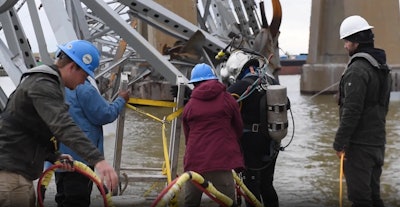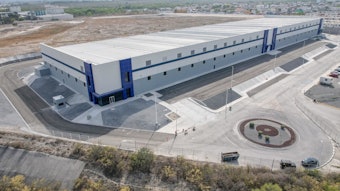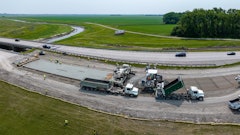
It's such a sensible adage that it might come off as trite, but it's no joke. The credo of many morning jobsite meetings in the construction industry is, "Get everyone home safe at the end of the day."
It's certainly the call to action of initiatives like Construction Safety Week, which takes place May 6-10 this year, and is the basis for ongoing research into improved safety technology, such as wearables.
Regardless, though, of the warnings, trainings and new gear, construction remains the fourth most dangerous industry in the country, with the fourth-most injuries and deaths, according to the National Safety Council. Many factors play a role in the presence of danger on a jobsite: moving equipment, working from heights, workers' physical conditions, severe weather and more. No matter the effort put in, it's not always possible to keep everyone safe all the time.
That unfortunate circumstance became clear when the cargo ship Dali slammed into the Francis Scott Key Bridge in the Baltimore Harbor on March 26. Six construction workers who had been filling potholes on the bridge at the time are thought to have died. A fifth worker's body was recovered from the harbor on May 1, according to the Unified Command, which includes the U.S. Coast Guard and several other agencies, who are working on recovery efforts in Baltimore.
The fifth victim was identified as Miguel Angel Luna Gonzalez, 49, of Glen Burnie, Md. Previously identified workers killed in the bridge collapse include Alejandro Hernandez Fuentes, 35, of Baltimore; Dorlian Ronial Castillo Cabrera, 26, of Dundalk, Md.; Carlos Daniel Hernández of Mexico and Maynor Yassir Suazo Sandoval, 49, originally from Guatemala. Jose Mynor Lopez, 35, of Dundalk, remains missing. They were employed by Brawner Builders and most had moved to the United States from Mexico, Guatemala and Honduras.
“We continue to pray for Miguel Angel Luna Gonzalez, his family and all those who love him, acknowledging the anguish they have experienced since the Key Bridge collapsed," said Maryland Gov. Wes Moore in a press release this week. "We pray for comfort, we pray for healing, and we pray for peace in knowing that their loved one has finally come home."
On Wednesday, Unified Command salvage teams located one of the missing construction vehicles and promptly notified the Maryland Department of State Police. Maryland State Police investigators along with officers from the Maryland Transportation Authority Police and the FBI responded to the scene and recovered Gonzalez's body inside a red truck. Assistance was also provided by the Maryland State Police Underwater Recovery Team and Crime Scene Unit.
“We remain dedicated to the ongoing recovery operations while knowing behind each person lost in this tragedy lies a loving family,” said Col. Roland L. Butler, Jr., superintendent of the Maryland Department of State Police. “Along with our local, state and federal partners, we ask that everyone extend their deepest sympathies and support to the families during this difficult time.”
The city of Baltimore has established an emergency response fund to help the families of the victims. The Key Bridge Emergency Response Fund is available at https://secure.qgiv.com/for/265-mima-keybridgeemergencyresponse/ and 100% of funding goes to victims affected by the disaster.
 Divers operating with the Key Bridge Response 2024 Unified Command conduct dive operations at the wreckage site of the M/V DALI and the Francis Scott Key Bridge in Baltimore, April 4, 2024. These divers conduct surveys beneath the surface of the water to provide the Unified Command with information on the underwater wreckage.U.S. Coast Guard Petty Officer 3rd Class Omar Faba
Divers operating with the Key Bridge Response 2024 Unified Command conduct dive operations at the wreckage site of the M/V DALI and the Francis Scott Key Bridge in Baltimore, April 4, 2024. These divers conduct surveys beneath the surface of the water to provide the Unified Command with information on the underwater wreckage.U.S. Coast Guard Petty Officer 3rd Class Omar Faba
Be Wary of Force Majeure Clauses
Back in 2007, the Interstate-35W Mississippi River Bridge collapsed, killing 13. The incident is ranked as the eighth worst bridge collapse in history.
Eric Ruzicka, partner at the international law firm Dorsey & Whitney, is a commercial litigator who specializes in the area of construction, infrastructure and real estate litigation. He represented a major engineering firm in a lawsuit related to the Minneapolis bridge collapse. He said the Minnesota and Baltimore bridge collapses have many similarities.
"It's a tremendous tragedy and shocking to see," he said. "Anyone who remembers the Minnesota bridge collapse was probably having flashbacks."
He said the bridges were similar in style and were built at about the same time. The recovery efforts and cleaning out of the harbors are similar between the two bridges collapses, as well. At least one of the victims of the Minneapolis bridge collapse was a construction worker who was working on the bridge.
Based on his experience with the Minneapolis bridge collapse, Ruzicka advises construction contractors to be aware of the ripple effect the Baltimore bridge collapse could have on the region. Shipping delays could slow the delivery of construction materials of projects. Construction companies should be notifiying insurance companies of any losses. They should also keep a close eye on project contracts and document all costs related to project delays caused by the bridge collapse.
"The key is always focusing on the contract," he said. "The important part is the notice provisions and providing correct notice and to record what is happening and its impacts."
For construction companies and their ongoing projects, the bridge collapse could trigger contractual force majeure clauses. Force majeure clauses go into effect when a natural disaster or similar unexpected situations makes further progress on a construction project impossible or delayed, and relieves the contractor from certain contractual responsibilities and liabilities. As with any legal situation, there are typically many particulars that need to be sorted out, relevant to the incidents and construction projects at hand. It's important to consult the company lawyer about the situation to ensure all requirements are being met.





























